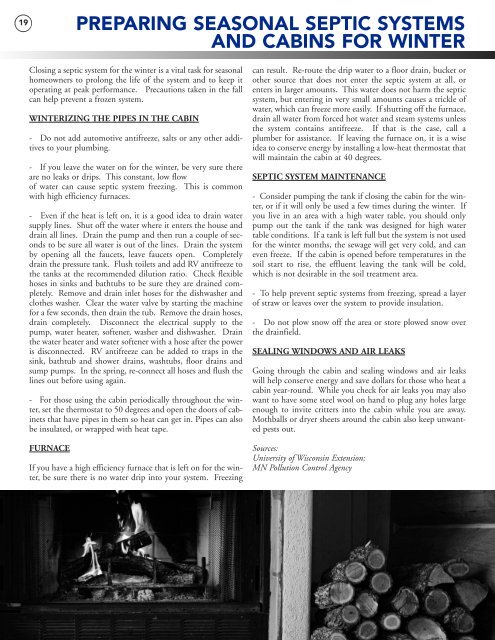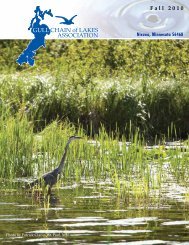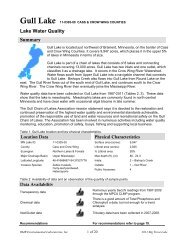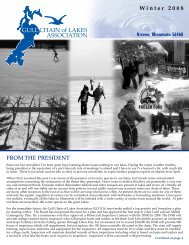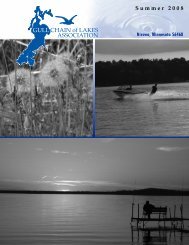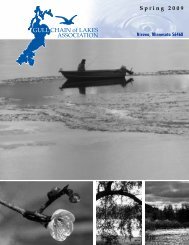Fall - Gull Chain of Lakes Association
Fall - Gull Chain of Lakes Association
Fall - Gull Chain of Lakes Association
- No tags were found...
Create successful ePaper yourself
Turn your PDF publications into a flip-book with our unique Google optimized e-Paper software.
19PREPARING SEASONAL SEPTIC SYSTEMSAND CABINS FOR WINTERClosing a septic system for the winter is a vital task for seasonalhomeowners to prolong the life <strong>of</strong> the system and to keep itoperating at peak performance. Precautions taken in the fallcan help prevent a frozen system.WINTERIZING THE PIPES IN THE CABIN- Do not add automotive antifreeze, salts or any other additivesto your plumbing.- If you leave the water on for the winter, be very sure thereare no leaks or drips. This constant, low flow<strong>of</strong> water can cause septic system freezing. This is commonwith high efficiency furnaces.- Even if the heat is left on, it is a good idea to drain watersupply lines. Shut <strong>of</strong>f the water where it enters the house anddrain all lines. Drain the pump and then run a couple <strong>of</strong> secondsto be sure all water is out <strong>of</strong> the lines. Drain the systemby opening all the faucets, leave faucets open. Completelydrain the pressure tank. Flush toilets and add RV antifreeze tothe tanks at the recommended dilution ratio. Check flexiblehoses in sinks and bathtubs to be sure they are drained completely.Remove and drain inlet hoses for the dishwasher andclothes washer. Clear the water valve by starting the machinefor a few seconds, then drain the tub. Remove the drain hoses,drain completely. Disconnect the electrical supply to thepump, water heater, s<strong>of</strong>tener, washer and dishwasher. Drainthe water heater and water s<strong>of</strong>tener with a hose after the poweris disconnected. RV antifreeze can be added to traps in thesink, bathtub and shower drains, washtubs, floor drains andsump pumps. In the spring, re-connect all hoses and flush thelines out before using again.- For those using the cabin periodically throughout the winter,set the thermostat to 50 degrees and open the doors <strong>of</strong> cabinetsthat have pipes in them so heat can get in. Pipes can alsobe insulated, or wrapped with heat tape.FURNACEIf you have a high efficiency furnace that is left on for the winter,be sure there is no water drip into your system. Freezingcan result. Re-route the drip water to a floor drain, bucket orother source that does not enter the septic system at all, orenters in larger amounts. This water does not harm the septicsystem, but entering in very small amounts causes a trickle <strong>of</strong>water, which can freeze more easily. If shutting <strong>of</strong>f the furnace,drain all water from forced hot water and steam systems unlessthe system contains antifreeze. If that is the case, call aplumber for assistance. If leaving the furnace on, it is a wiseidea to conserve energy by installing a low-heat thermostat thatwill maintain the cabin at 40 degrees.SEPTIC SYSTEM MAINTENANCE- Consider pumping the tank if closing the cabin for the winter,or if it will only be used a few times during the winter. Ifyou live in an area with a high water table, you should onlypump out the tank if the tank was designed for high watertable conditions. If a tank is left full but the system is not usedfor the winter months, the sewage will get very cold, and caneven freeze. If the cabin is opened before temperatures in thesoil start to rise, the effluent leaving the tank will be cold,which is not desirable in the soil treatment area.- To help prevent septic systems from freezing, spread a layer<strong>of</strong> straw or leaves over the system to provide insulation.- Do not plow snow <strong>of</strong>f the area or store plowed snow overthe drainfield.SEALING WINDOWS AND AIR LEAKSGoing through the cabin and sealing windows and air leakswill help conserve energy and save dollars for those who heat acabin year-round. While you check for air leaks you may alsowant to have some steel wool on hand to plug any holes largeenough to invite critters into the cabin while you are away.Mothballs or dryer sheets around the cabin also keep unwantedpests out.Sources:University <strong>of</strong> Wisconsin Extension;MN Pollution Control Agency


